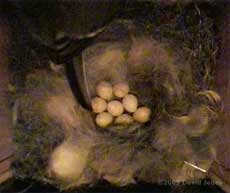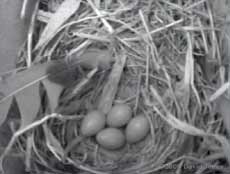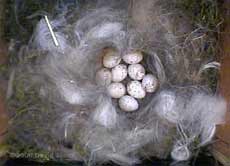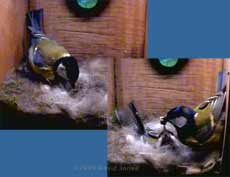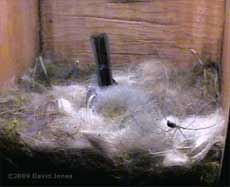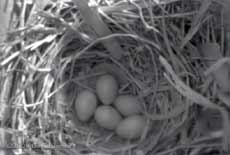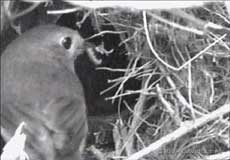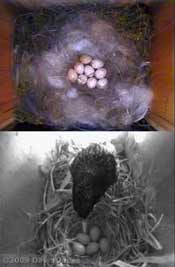Go to the last entry on this page .......,,,.. Go to previous entry11 April - Great Tit egg #8; Starling egg #4 - As expected, there is no sign of the Robin female this morning, confirming that she has indeed abandoned the eggs. However, the male continues to visit with food. At around 8.30am he turned up with a spider (still wriggling). As I write this at 8.40am the Starling is in the box and has just settled down into the nest cup. It may be another hour or so before she produces her next egg. In the Great Tit box the eggs are covered over (the female brought in some more soft bedding a few minutes ago) so I'll need to look at the early morning recording to confirm egg #8. She has just brought in some more at 8.45am.
I haven't been able to establish when the eight egg was laid, but here it is, exposed at 6am when the female was looking out of the box and calling for her mate.
It was around 10am when the Starling laid her fourth egg.
The webcam has been revised to give both views of the Great Tit box, although I have retained the image of the Robin box for the moment, just in case there is any further activity around it. It means that for the moment Starling Box L isn't on show. although I will be monitoring it, and it may well be brought back into use by the Starlings once the present clutch fledges. There may not be any more entries today as we are getting ready for a family get-together this evening.
12 April - Great Tit egg #9; Starling egg #5-
It looks as though at least 'part time' incubation has started, as the female has spent a couple of hours or so during the morning sitting on the eggs, and I have seen the male bring food to her several times.
Of the eight hours since she first left the box at 6.16am she has spent almost exactly four hours sitting on the eggs in six sessions averaging 42 minutes each (but ranging from a very long 81 minutes after 9am down to 24 minutes at the beginning of the afternoon). Before 9am the female also made two brief visits just to bring in soft bedding without staying for more than a few seconds. During the same eight hour period the male brought food to her four times. After 2pm there was a drastic change in the statistics. She was in the nest for 29 minutes between 2.24 - 2.53pm, and a further 2 minutes at 3.20pm. Just a minute later she brought in a bit of bedding and then disappeared for the rest of the afternoon.
She didn't return until 6.49pm, when she started to settle for the night. The male appeared at 6.56pm with a beakful of food for her. That long gap this afternoon suggests to me that we should expect at least one more egg before incubation gets under way properly.
If you have been following the webcam you will have seen that the Pholcus phalangioides spiders have been particularly active this afternoon. Fortunately for them there is glass protecting them from the Great Tits. However, it does mean that I will need to spend a few minutes down the box tomorrow, clearing their webs from the area between the glass and the camera.
The Starling left the box for the first time at 6.30am and at 9am the Starling was sitting in the nest, breathing slowly (60bpm) and quite deeply, so it looked as though egg #5 would appear in the next hour.
- And that happened soon after 10am. The eggs have been left uncovered for only short periods during the morning so I'm wondering if the clutch is possibly complete now. Starlings can lay up to seven eggs.
It is interesting to compare the times spent in their nests by the Starling and the Great Tit this morning. I have gone through a similar eight hour period as I did for the Great Tit, starting when the Starling left her nest at 6.30am. Of the eight hours she spent over six hours on the eggs, in 20 sessions, averaging around 18½ minutes and ranging from 63 minutes (the period around egg laying) down to just 1 minute. At no time did I see two birds in the box this morning, and I think it was only the female who was sitting on the eggs. Unlike the Great Tit, after 2.30pm the Starling continued her sessions in the box right through until she retired for the night at 7.03pm. In that period she spent 3 hours (out of 4hr 33min) sitting in sixteen sessions (slightly disrupted by some unsettled coming and going in the late afternoon) averaging around 11 minutes (ranging between 18 minutes and less than i minute).
It seems that the Male Robin still has hopes of his partner returning to the nest. He arrived at the box at 6.41am with a caterpillar and other bits in his beak, and returned several times over the next few minutes. He appeared again at just after 11am and then several times between 12.38-12.45pm, each time with food in his beak. At other times during the day he has been singing loudly in the Hawthorn.
The Blue Tit turned up to roost at 7.47pm last night and left this morning at 5.31am. This evening it arrived at 7.45pm.
13 April - No more eggs laid this morning -
Just a brief note this evening to confirm that no further eggs have been laid by either the Great Tit or the Starling. I've not been able to go through any of the day's recordings as I've been struck down by a bug of some sort and spent most of the day off my feet - hopefully it will be gone by tomorrow!
14 April - While the bug hasn't quite gone I hope to get back to some sort of normality today. I want to spend some time on the garden diary, but I may get around to putting together some figures on today's incubation routines in the two boxes. In the meantime, a couple of bits to fill in some of the gap left yesterday - I've had a look at yesterday's recordings and it appears as though the male Robin only visited the nestbox once all day, at 5.24pm, so it looks as though that particular episode is all but over. If there are no visits today I will be switching that camera off and returning to the camera in Starling box L. The Blue Tit continues to be consistent in its roosting behaviour, leaving House Martin nest 3 at 5.25am, then returning at 7.42pm yesterday, and this morning leaving at 5.22am. I noticed from yesterday's recording that the evening sunshine was causing havoc with the image from the Starling box R camera as bright light struck dust on the lens. I'm afraid that cleaning the lens will have to wait a couple of days at least before I can start going up a ladder again. I will, however, be going down to change the glass and sort out the spider webs that are affecting the image from the rear camera in the Great Tit box.
19 April - Incubation continues with no problems for either the Great Tits or Starlings and today, at last, I've had enough patience to sit and look through a full day's recording. I'll start off with the simplest observations - The Blue Tit left its roost at 5.24am and returned at 7.38pm. After watching the skies on and off over the last week, I finally caught sight of a single House Martin this evening, at least I saw it in silhouette as it flew towards the east high over us. It's too soon to get excited, but I will be watching again tomorrow with the big lens ready to record any that I see.
The Great Tit incubation is very similar to that of the Robin in most respects, with just the female sitting on the eggs and the male bringing food, especially in the mornings. Today, the female left the nest for the first time at 6.11am and returned for the night at 5.50pm. Between those limits she sat on the eggs for a total of 603 minutes in 16 sessions, averaging just under 37¾ minutes. She left the nest 17 times, usually for no more than 10 minutes, although she stayed out for 29 minutes just after 1pm. The male brought food into the box for her 10 times, of which six were before 8am. He also entered the box twice while the female was absent. During the first of these he spent some time giving the eggs a close inspection and appeared to remove some bits from the nest cup, although at no time did he sit on the eggs. During the other visit he arrived with a caterpillar in his beak which he took back out with him.
The Starlings have a very different approach incubation which made it quite difficult to come up with really accurate figures without taking much longer than I could manage. The female, having spent the night on the eggs left the nest for the first time at 6.02am, and returned for the night at 7.26pm. In between, both birds take turns at sitting on the eggs so that they were left uncovered for less than an hour all day, the longest period being around 8 minutes during the afternoon. For each bird, a sitting on the eggs is usually not very long. I counted 33 definite change-overs in the box when the second bird would enter while the partner was still sitting. In addition, some times one bird would leave before the other entered. I counted 16 occasions where this happened so that the box was unoccupied for less than two minutes, and another 7 occasions when the gap was up to two minutes. There were only to periods when the eggs were left uncovered for longer, for 8 and 7 minutes during the afternoon. The frequency at which they changed places meant that a session on the eggs sometimes lasted just a couple of minutes, especially during the first part of the morning. During the afternoon things quietened down somewhat. The longest session of the day took place when the female was in the box between 5.01pm and 5.58pm. Mind you, that doesn't mean that she sat on the eggs for the full 57 minutes - she went to the entrance to look out (for her partner?) six times. At no time did I see food exchanged between partners, although during the morning especially the bird (male and female) arriving in the box would have straw or a feather in its beak.
- Click on the images to see larger versions - |
|
